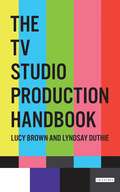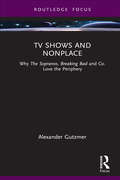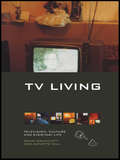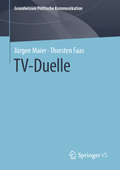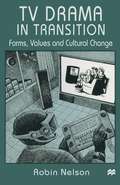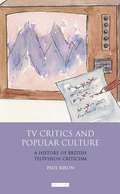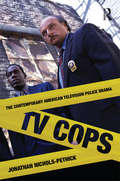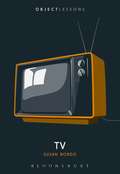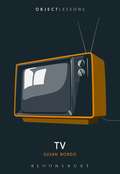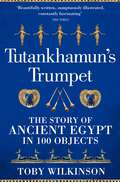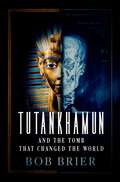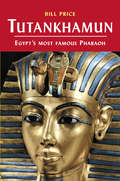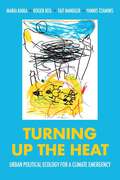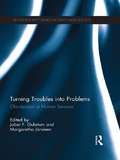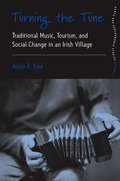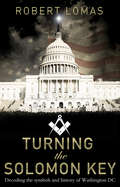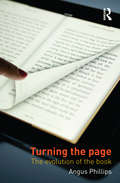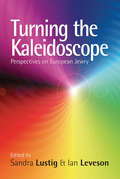- Table View
- List View
The TV Studio Production Handbook
by Lucy Brown Lyndsay DuthieHere is the one-stop handbook to make your studio production shine.
TV Shows and Nonplace: Why The Sopranos, Breaking Bad and Co. Love the Periphery (Routledge Focus on Television Studies)
by Alexander GutzmerThis book scrutinizes the relationship between contemporary TV shows and space, focusing on the ways in which these shows use and narrate specific spatial structures, namely, spaces far away from traditional metropolises. Beginning with the observation that many shows are set in specific spatial settings, referred to in the book as “nonplace territories” – e.g., North Jersey, New Mexico, or rural and suburban Western Germany – the author argues that the link between such nonplace territories and shows such as The Sopranos, Breaking Bad, or Dark is so intense because the narrative structure functions similarly to these territories: flat, decentralized, without any sense of structure or stable hierarchy. The book takes three different perspectives: first, it looks at the rationale for combining TV shows and nonplace territories from the viewpoint of narrative strategy. It then thinks through what these strategies mean for practicing architects. Finally, it approaches the arguments made before from a “user” perspective: what does this narrative mirroring of social-spatial reality in places such as Albuquerque or Jersey City mean for people living in these places? This new approach to architecture and space on screen will interest scholars and students of television studies, screen architecture, media and architectural theory, and popular culture.
TV Shows and Nonplace: Why The Sopranos, Breaking Bad and Co. Love the Periphery (Routledge Focus on Television Studies)
by Alexander GutzmerThis book scrutinizes the relationship between contemporary TV shows and space, focusing on the ways in which these shows use and narrate specific spatial structures, namely, spaces far away from traditional metropolises. Beginning with the observation that many shows are set in specific spatial settings, referred to in the book as “nonplace territories” – e.g., North Jersey, New Mexico, or rural and suburban Western Germany – the author argues that the link between such nonplace territories and shows such as The Sopranos, Breaking Bad, or Dark is so intense because the narrative structure functions similarly to these territories: flat, decentralized, without any sense of structure or stable hierarchy. The book takes three different perspectives: first, it looks at the rationale for combining TV shows and nonplace territories from the viewpoint of narrative strategy. It then thinks through what these strategies mean for practicing architects. Finally, it approaches the arguments made before from a “user” perspective: what does this narrative mirroring of social-spatial reality in places such as Albuquerque or Jersey City mean for people living in these places? This new approach to architecture and space on screen will interest scholars and students of television studies, screen architecture, media and architectural theory, and popular culture.
TV Living: Television, Culture and Everyday Life
by David Gauntlett Annette HillTV Living presents the findings of the BFI Audience Tracking Study in which 500 participants completed detailed questionnaire-diaries on their lives, their television watching, and the relationship between the two over a five year period.Gauntlett and Hill use this extensive data to explore some of the most fundamental questions in media and cultural studies, focusing on issues of gender, identity, the impact of new technologies, and life changes. Opening up new areas of debate, the study sheds new light on audiences and their responses to issues such as sex and violence on television. A unique study of contemporary tv audience behaviour and attitudes, TV Living offers a fascinating insight into the complex relationship between mass media and people's lives today.
TV Living: Television, Culture and Everyday Life
by David Gauntlett Annette HillTV Living presents the findings of the BFI Audience Tracking Study in which 500 participants completed detailed questionnaire-diaries on their lives, their television watching, and the relationship between the two over a five year period.Gauntlett and Hill use this extensive data to explore some of the most fundamental questions in media and cultural studies, focusing on issues of gender, identity, the impact of new technologies, and life changes. Opening up new areas of debate, the study sheds new light on audiences and their responses to issues such as sex and violence on television. A unique study of contemporary tv audience behaviour and attitudes, TV Living offers a fascinating insight into the complex relationship between mass media and people's lives today.
TV-Duelle (Grundwissen Politische Kommunikation)
by Jürgen Maier Thorsten FaasTV-Duelle sind ein fester Bestandteil und zugleich das wichtigste Einzelereignis in modernen Wahlkämpfen. Sie werden von Millionen von Zuschauerinnen und Zuschauern gesehen und umfassend in Massenmedien, aber zunehmend auch in den neuen Medien begleitet. Das vorliegende Buch gibt einen Überblick über Geschichte, Nutzung, Inhalte und Wirkungen von TV-Duellen. Im Fokus stehen dabei vor allem TV-Duelle in Deutschland. Der InhaltTV-Duelle in modernen Wahlkämpfen • Debattenforschung, aber wie? • Geschichte, Verbreitung und Varianten von TV-Duellen • Debatteninhalte und Debattenstrategien • Nutzung von TV-Duellen: Umfang, Rezipientenmerkmale und -motive • Wahrnehmung von TV-Duellen und Wahrnehmung des Debattensiegers • Wirkung von TV-Duellen • Kommunikation über TV-Duelle • Was gibt es nach 60 Jahren Debattenforschung noch zu untersuchen?Die AutorenProf. Dr. Jürgen Maier ist Professor für Politische Kommunikation an der Universität Koblenz-Landau. Seine aktuellen Arbeitsschwerpunkte liegen in den Bereichen Politische Kommunikation, Wahlen und politische Einstellungen sowie Einsatz experimenteller Designs bei der Untersuchung sozialwissenschaftlicher Fragestellungen.Prof. Dr. Thorsten Faas leitet die Arbeitsstelle "Politische Soziologie der Bundesrepublik Deutschland" am Otto-Suhr-Institut für Politikwissenschaft an der Freien Universität Berlin. Seine Arbeitsschwerpunkte liegen im Bereich von Wahlen, Wahlkämpfen und Wahlstudien.
TV Drama in Transition: Forms, Values and Cultural Change
by Robin NelsonTV Drama in Transition reflects upon changing dramatic forms on television in the context of broad cultural shifts over the past two decades. Analyses of a wide range of series (from Heartbeat to Middlemarch and Our Friends in the North; from NYPD Blue to Twin Peaks to The X-Files) are interspersed with accounts of new technologies, viewing dispositions and the political economy of culture. This book is generally concerned as much with the condition of culture in the 1980s and 1990s, as specifically with TV drama.
TV Critics and Popular Culture: A History of British Television Criticism (International Library of Cultural Studies)
by Paul RixonEver since the first scheduled television broadcasts began in the 1930s, newspapers and magazines took quickly to reviewing this revolutionary and popular new medium. The task of television criticism in the public doman intially fell to radio critics and journalists, but the 1950s saw the rise of the dedicated TV critic. Such critics appeared at a time when Britain was undergoing dramatic cultural and social change - and television was widely perceived to play an important role in this change. Over the years, critics such as Peter Black, Philip Pursor, Clive James and Mark Lawson have played an important part in shaping the public discourse about television. Studying the discourse of such critics provides a unique insight into public attitudes to TV, the values by which TV has been judged, and adds to our understanding of the way in which TV has become such an integral part of modern British culture.TV Critics and Popular Culture is the first book to examine the evolution of television criticism in Britain, exploring different types of TV critics and reviewers, the form of their work, the critical language used, the programmes reviewed and the underlying values at work. The analysis is contextualised in relation to wider cultural debates and developments in television and journalism. Alongside this historical-theoretical analysis, the book also explores the perennial question of what the role of the TV critic is, how and why it changes, and whether, with the birth of new technologies, is the TV critic a dying breed? This is an important contribution to the history of Journalism and Television Studies, and to Media Studies and Cultural Studies more widely.
TV Cops: The Contemporary American Television Police Drama
by Jonathan Nichols-PethickThe police drama has been one of the longest running and most popular genres in American television. In TV Cops, Jonathan Nichols-Pethick argues that, perhaps more than any other genre, the police series in all its manifestations—from Hill Street Blues to Miami Vice to The Wire—embodies the full range of the cultural dynamics of television. Exploring the textual, industrial, and social contexts of police shows on American television, this book demonstrates how polices drama play a vital role in the way we understand and engage issues of social order that most of us otherwise experience only in such abstractions as laws and crime statistics. And given the current diffusion and popularity of the form, we might ask a number of questions that deserve serious critical attention: Under what circumstances have stories about the police proliferated in popular culture? What function do these stories serve for both the television industry and its audiences? Why have these stories become so commercially viable for the television industry in particular? How do stories about the police help us understand current social and political debates about crime, about the communities we live in, and about our identities as citizens?
TV Cops: The Contemporary American Television Police Drama
by Jonathan Nichols-PethickThe police drama has been one of the longest running and most popular genres in American television. In TV Cops, Jonathan Nichols-Pethick argues that, perhaps more than any other genre, the police series in all its manifestations—from Hill Street Blues to Miami Vice to The Wire—embodies the full range of the cultural dynamics of television. Exploring the textual, industrial, and social contexts of police shows on American television, this book demonstrates how polices drama play a vital role in the way we understand and engage issues of social order that most of us otherwise experience only in such abstractions as laws and crime statistics. And given the current diffusion and popularity of the form, we might ask a number of questions that deserve serious critical attention: Under what circumstances have stories about the police proliferated in popular culture? What function do these stories serve for both the television industry and its audiences? Why have these stories become so commercially viable for the television industry in particular? How do stories about the police help us understand current social and political debates about crime, about the communities we live in, and about our identities as citizens?
TV (Object Lessons)
by Susan BordoObject Lessons is a series of short, beautifully designed books about the hidden lives of ordinary things. Once upon a time, the news was only 15 minutes long and middle-class families huddled around a tiny black-and-white screen, TV dinners on their laps, awaiting weekly sitcoms that depicted an all-white world in which mom wore pearls and heels as she baked endless pies. If this seems a distant past, that's a measure of just how much TV has changed-and changed us. Weaving together personal memoir, social and political history, and reflecting on key moments in the history of news broadcasting and prime time entertainment, Susan Bordo opens up the 75-year-old time-capsule that is TV and illustrates what a constant companion and dominant cultural force television has been, for good and for bad, in carrying us from the McCarthy hearings and The Adventures of Ozzie and Harriet to Mad Men, Killing Eve, and the emergence of our first reality TV president.Object Lessons is published in partnership with an essay series in The Atlantic.
TV (Object Lessons)
by Susan BordoObject Lessons is a series of short, beautifully designed books about the hidden lives of ordinary things. Once upon a time, the news was only 15 minutes long and middle-class families huddled around a tiny black-and-white screen, TV dinners on their laps, awaiting weekly sitcoms that depicted an all-white world in which mom wore pearls and heels as she baked endless pies. If this seems a distant past, that's a measure of just how much TV has changed-and changed us. Weaving together personal memoir, social and political history, and reflecting on key moments in the history of news broadcasting and prime time entertainment, Susan Bordo opens up the 75-year-old time-capsule that is TV and illustrates what a constant companion and dominant cultural force television has been, for good and for bad, in carrying us from the McCarthy hearings and The Adventures of Ozzie and Harriet to Mad Men, Killing Eve, and the emergence of our first reality TV president.Object Lessons is published in partnership with an essay series in The Atlantic.
Tutankhamun's Trumpet: The Story of Ancient Egypt in 100 Objects
by Toby WilkinsonOn 26 November 1922 Howard Carter first peered into the newly opened tomb of an ancient Egyptian boy-king. When asked if he could see anything, he replied: ‘Yes, yes, wonderful things.’ In Tutankhamun’s Trumpet, acclaimed Egyptologist Toby Wilkinson takes a unique approach to a well-worn subject. Instead of concentrating on the oft-told story of the discovery, or speculating on the (brief) life and (fractious) times of the boy-king, Wilkinson takes the objects buried with the king as the source material for a wide-ranging, detailed portrait of ancient Egypt – its geography, history, culture and legacy. One hundred artefacts from the tomb, arranged in ten thematic groups, are allowed to speak again – not only for themselves, but as witnesses of the civilization that created them. Never before have the treasures of Tutankhamun been analyzed and presented for what they can tell us about ancient Egyptian culture, its extraordinary development, its remarkable flourishing, and its lasting impact. Like Tutankhamun himself, the music which surrounded him has vanished. All that remains are echoes of the past, survivors of an age long gone, the stuff of interpretation and reinterpretation. But through the objects buried with him, his world, and the civilization of ancient Egypt of which he remains the ultimate symbol, can be brought back to life. Filled with surprising insights, unusual details, vivid descriptions and, above all, remarkable objects, Tutankhamun’s Trumpet will appeal to all lovers of history, archaeology, art and culture, as well as all those fascinated by the Egypt of the pharaohs.
Tutankhamun and the Tomb that Changed the World
by Bob BrierA major new look at the treasures and mysteries of Tutankhamun's tomb on the centenary of its discovery. It is often thought that the story of Tutankhamun ended when the thousands of items discovered by Howard Carter and Lord Carnarvon were transported to the Egyptian Museum in Cairo and put on display. But there is far more to Tutankhamun's story. Tutankhamun and the Tomb that Changed the World explores the 100 years of research on Tutankhamun that has taken place since the tomb's discovery: we learn that several objects in the tomb were made of meteoritic iron that came from outer space; new evidence shows that Tutankhamun may have been a warrior who went into battle; and author Bob Brier takes readers behind the scenes of the recent CAT-scanning of his mummy to reveal secrets of the pharaoh. The book also illustrates the wide-ranging impact the discovery of Tutankhamun's tomb had on fields beyond Egyptology. Included is an examination of how the discovery of the tomb influenced Egyptian politics and contributed to the downfall of colonialism in Egypt. Outside Egypt, the modern blockbuster exhibitions that raise great sums of monies for museums around the world all began with Tutankhamun, as did the idea of documenting every object discovered in place, before it was moved. And to a great extent, the modern fascination with ancient Egypt--Egyptomania--was also greatly promoted by the Tutmania that surrounded the discovery of the tomb.
Tutankhamun and the Tomb that Changed the World
by Bob BrierA major new look at the treasures and mysteries of Tutankhamun's tomb on the centenary of its discovery. It is often thought that the story of Tutankhamun ended when the thousands of items discovered by Howard Carter and Lord Carnarvon were transported to the Egyptian Museum in Cairo and put on display. But there is far more to Tutankhamun's story. Tutankhamun and the Tomb that Changed the World explores the 100 years of research on Tutankhamun that has taken place since the tomb's discovery: we learn that several objects in the tomb were made of meteoritic iron that came from outer space; new evidence shows that Tutankhamun may have been a warrior who went into battle; and author Bob Brier takes readers behind the scenes of the recent CAT-scanning of his mummy to reveal secrets of the pharaoh. The book also illustrates the wide-ranging impact the discovery of Tutankhamun's tomb had on fields beyond Egyptology. Included is an examination of how the discovery of the tomb influenced Egyptian politics and contributed to the downfall of colonialism in Egypt. Outside Egypt, the modern blockbuster exhibitions that raise great sums of monies for museums around the world all began with Tutankhamun, as did the idea of documenting every object discovered in place, before it was moved. And to a great extent, the modern fascination with ancient Egypt--Egyptomania--was also greatly promoted by the Tutmania that surrounded the discovery of the tomb.
Tutankhamun: Egypt's most famous Pharaoh (Pocket Essential Ser.)
by Bill PriceIn 1922 Howard Carter uncovered what is still regarded as the most spectacular archaeological discovery ever made. Tutankhamun's tomb had remained hidden in the Valley of the Kings for more than 3000 years and its discovery caused a media sensation, elevating the previously little-known Egyptian Pharaoh into the position of an international celebrity. The contents of the tomb were found almost entirely intact, including the Pharaoh's mummified body, still wearing its solid gold funeral mask.Tutankhamun lived in an era when the Egyptian Empire, centred on the royal city of Thebes, was at its pinnacle and when the wealth and power of its Pharaoh was at its greatest. This was also a period of enormous religious upheaval. Akenaten, the heretical Pharaoh and, more than likely, Tutanhkamun's father, had introduced a new religion, exclusively worshipping the sun god Aten. Under Tutanhkamun, the old religion, with its many gods and goddesses, was restored, putting an end to the heresy.In recent years research has shed new light on Tutankhamun's life and, in particular, on his death. Public interest in the boy king is as strong as ever and our knowledge of the sophisticated and complex society over which he reigned continues to grow.
Turning up the heat: Urban political ecology for a climate emergency
by Maria Kaika Roger Keil Tait Mandler Yannis TzaninisSince its emergence in the 1990s, the field of Urban Political Ecology (UPE) has focused on unsettling traditional understandings of the ‘city’ as entirely distinct from nature, showing instead how cities are metabolically linked with ecological processes and the flow of resources. More recently, a new generation of scholars has turned the focus towards the climate emergency. Turning up the heat seeks to turn UPE's critical energies towards a politically engaged debate over the role of extensive urbanisation in addressing socio-environmental equality in the context of climate change.The collection brings together theoretical discussions and rigorous empirical analysis by key scholars spanning three generations, engaging UPE in current debates about urbanisation and climate change. Engaging with cutting edge approaches including feminist political ecology, circular economies, and the Anthropocene, case studies in the book range from Singapore and Amsterdam to Nairobi and Vancouver. Contributors make the case for a UPE better informed by situated knowledges: an embodied UPE that pays equal attention to the role of postcolonial processes and more-than-human ontologies of capital accumulation within the context of the climate emergency. Acknowledging UPE’s rich intellectual history and aiming to enrich rather than split the field, Turning up the heat reveals how UPE is ideally positioned to address contemporary environmental issues in theory and practice.
Turning up the heat: Urban political ecology for a climate emergency
by Maria Kaika, Roger Keil, Tait Mandler, and Yannis TzaninisSince its emergence in the 1990s, the field of Urban Political Ecology (UPE) has focused on unsettling traditional understandings of the ‘city’ as entirely distinct from nature, showing instead how cities are metabolically linked with ecological processes and the flow of resources. More recently, a new generation of scholars has turned the focus towards the climate emergency. Turning up the heat seeks to turn UPE's critical energies towards a politically engaged debate over the role of extensive urbanisation in addressing socio-environmental equality in the context of climate change.The collection brings together theoretical discussions and rigorous empirical analysis by key scholars spanning three generations, engaging UPE in current debates about urbanisation and climate change. Engaging with cutting edge approaches including feminist political ecology, circular economies, and the Anthropocene, case studies in the book range from Singapore and Amsterdam to Nairobi and Vancouver. Contributors make the case for a UPE better informed by situated knowledges: an embodied UPE that pays equal attention to the role of postcolonial processes and more-than-human ontologies of capital accumulation within the context of the climate emergency. Acknowledging UPE’s rich intellectual history and aiming to enrich rather than split the field, Turning up the heat reveals how UPE is ideally positioned to address contemporary environmental issues in theory and practice.
Turning Troubles into Problems: Clientization in Human Services (Routledge Key Themes in Health and Society)
by Jaber F. Gubrium Margaretha JärvinenHuman service professionals deal with a wide range of problems, from child abuse, parenting issues, and elderly care, to addictions, mental illness, sexual assault, unemployment, and criminality. These must be constructed as problems for professionals to appropriately respond to them. Human service provision starts from there. But in the everyday experience of service providers and users alike, there is a parallel world of ordinary troubles that remains professionally undefined but real, even when troubles are turned into problems. This book brings into view the relationship between these worlds as it bears on the process of clientization—the transformation of people and troubles into clients and problems. Rather than taking the process for granted as many critics do, the book examines the instability of the process on several fronts and highlights its surprising local complexity. Foregrounding everyday life, the leading idea is that the transformation of troubles into problems is not straightforward and that problems are continually subject to alternative understandings. This poses new what, how, and where questions. What are ordinary troubles and how do they relate to the construction, maintenance, or undoing of serviceable problems? Where is social policy and how does that figure in the front-line work of service provision? The questions point to the challenges of clientization at the discretionary border of troubles and problems in everyday service relationships. With chapters written by an international group of human service researchers, this book is an important contribution to the literature dealing with the construction of personal problems and will be useful to students and academics in sociology, human services, social work and policy, criminal justice, and health care.
Turning Troubles into Problems: Clientization in Human Services (Routledge Key Themes in Health and Society)
by Jaber F. Gubrium Margaretha JärvinenHuman service professionals deal with a wide range of problems, from child abuse, parenting issues, and elderly care, to addictions, mental illness, sexual assault, unemployment, and criminality. These must be constructed as problems for professionals to appropriately respond to them. Human service provision starts from there. But in the everyday experience of service providers and users alike, there is a parallel world of ordinary troubles that remains professionally undefined but real, even when troubles are turned into problems. This book brings into view the relationship between these worlds as it bears on the process of clientization—the transformation of people and troubles into clients and problems. Rather than taking the process for granted as many critics do, the book examines the instability of the process on several fronts and highlights its surprising local complexity. Foregrounding everyday life, the leading idea is that the transformation of troubles into problems is not straightforward and that problems are continually subject to alternative understandings. This poses new what, how, and where questions. What are ordinary troubles and how do they relate to the construction, maintenance, or undoing of serviceable problems? Where is social policy and how does that figure in the front-line work of service provision? The questions point to the challenges of clientization at the discretionary border of troubles and problems in everyday service relationships. With chapters written by an international group of human service researchers, this book is an important contribution to the literature dealing with the construction of personal problems and will be useful to students and academics in sociology, human services, social work and policy, criminal justice, and health care.
Turning the Tune: Traditional Music, Tourism, and Social Change in an Irish Village (Dance and Performance Studies #3)
by Adam KaulThe last century has seen radical social changes in Ireland, which have impacted all aspects of local life but none more so than traditional Irish music, an increasingly important identity marker both in Ireland and abroad. The author focuses on a small village in County Clare, which became a kind of pilgrimage site for those interested in experiencing traditional music. He begins by tracing its historical development from the days prior to the influx of visitors, through a period called "the Revival," in which traditional Irish music was revitalized and transformed, to the modern period, which is dominated by tourism. A large number of incomers, locally known as "blow-ins," have moved to the area, and the traditional Irish music is now largely performed and passed on by them. This fine-grained ethnographic study explores the commercialization of music and culture, the touristic consolidation and consumption of “place,” and offers a critique of the trope of "authenticity," all in a setting of dramatic social change in which the movement of people is constant.
Turning the Solomon Key: George Washington, The Bright Morning Star, And The Secrets Of Masonic Astrology
by Robert LomasWhen George Washington, first President of the United States, laid the foundation stone of the Capitol Building of the city that was to bear his name, he did so wearing full Masonic regalia. Turning The Solomon Key is a riveting quest to discover the Masonic influences George Washington brought to bear on the layout of Washington DC. History records that the builders of Washington DC knew a great Masonic secret about the human condition, and that their plans for the city were laid out on a Masonic grid rich in symbolism, hidden meaning and designed to express this secret power. Robert Lomas, an expert in the history of Freemasonry, goes in search of the truth behind this claim. Using Masonic rituals and Washington's diaries, Lomas uncovers the symbolic meaning behind the siting of the White House and the Capitol - and their connection to a secret passed down from one of the first Grand Masters of the Freemasons, King Solomon.Turning the Solomon Key delves into the true history behind many of the symbols and mysteries that feature in Dan Brown's latest international bestseller, The Lost Symbol, and will be essential reading for all who want to discover the real significance to the masonic secrets of Washington DC.
Turning the Page: The Evolution of the Book
by Angus PhillipsThis is an exciting period for the book, a time of innovation, experimentation, and change. It is also a time of considerable fear within the book industry as it adjusts to changes in how books are created and consumed. The movement to digital has been taking place for some time, but with consumer books experiencing the transition, the effects of digitization can be clearly seen to everybody. In Turning the Page Angus Phillips analyses the fundamental drivers of the book publishing industry - authorship, readership, and copyright - and examines the effects of digital and other developments on the book itself. Drawing on theory and research across a range of subjects, from business and sociology to neuroscience and psychology, and from interviews with industry professionals, Phillips investigates how the fundamentals of the book industry are changing in a world of ebooks, self-publishing, and emerging business models. Useful comparisons are also made with other media industries which have undergone rapid change, such as music and newspapers. This book is an ideal companion for anyone wishing to understand the transition of the book, writing and publishing in recent years and will be particularly relevant to students studying publishing, media and communications.
Turning the Page: The Evolution of the Book
by Angus PhillipsThis is an exciting period for the book, a time of innovation, experimentation, and change. It is also a time of considerable fear within the book industry as it adjusts to changes in how books are created and consumed. The movement to digital has been taking place for some time, but with consumer books experiencing the transition, the effects of digitization can be clearly seen to everybody. In Turning the Page Angus Phillips analyses the fundamental drivers of the book publishing industry - authorship, readership, and copyright - and examines the effects of digital and other developments on the book itself. Drawing on theory and research across a range of subjects, from business and sociology to neuroscience and psychology, and from interviews with industry professionals, Phillips investigates how the fundamentals of the book industry are changing in a world of ebooks, self-publishing, and emerging business models. Useful comparisons are also made with other media industries which have undergone rapid change, such as music and newspapers. This book is an ideal companion for anyone wishing to understand the transition of the book, writing and publishing in recent years and will be particularly relevant to students studying publishing, media and communications.
Turning the Kaleidoscope: Perspectives on European Jewry
by Sandra Lustig Ian LevesonFar from being a blank space on the Jewish map, or a void in the Jewish cultural world, post-Shoah Europe is a place where Jewry has continued to develop, even though it is facing different challenges and opportunities than elsewhere. Living on a continent characterized by highly diverse patterns of culture, language, history, and relations to Jews, European Jewry mirrors that kaleidoscopic diversity. This volume explores such key questions as the new roles for Jews in Europe; models of Jewish community organization in Europe; concepts of diaspora and galut; a European-Jewish way of life in the era of globalization; and European Jews' relationship to Israel and to non-Jews. Some contributions highlight experiences of Jews in Britain, Sweden, Norway, Hungary, Austria, Germany, and the Netherlands. Helping us to understand the special and common characteristics of European Jewry, this collection offers a valuable contribution to the continued rebuilding of Jewish life in the postwar era.
